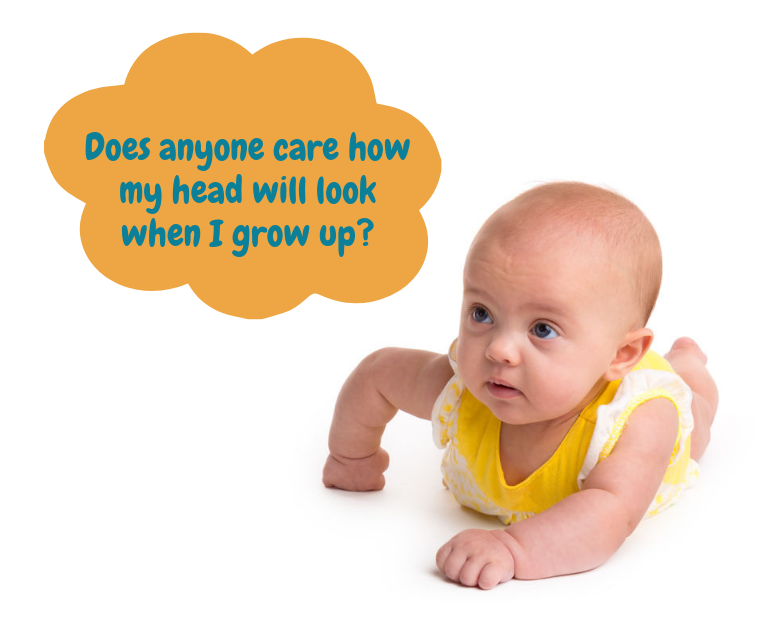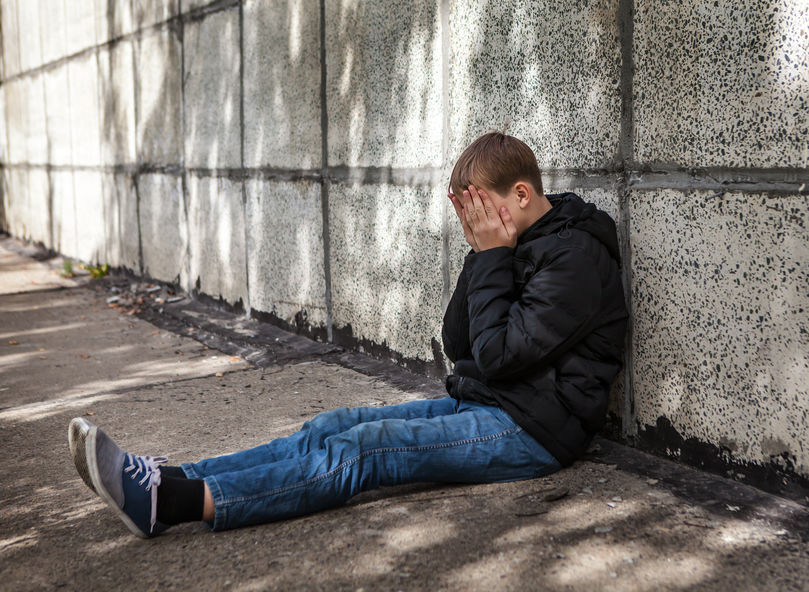Leaving Plagiocephaly and Torticollis Untreated
/

Since so much emphasis is placed by society on outward appearances, it is imperative for responsible parents to make sure that their child will not be bullied or made fun of in school or when he or she reaches adulthood. In days gone by, it was not as strange to come across a hunchback, a person with buck teeth, a limper or persons with other physical disabilities. The phrase, “it doesn’t matter what you look like on the outside, it’s what’s inside that counts”, is both outdated and hypocritical. It’s one thing if there is no cure for a disfigurement, however with the two syndromes that we are discussing, plagiocephaly and torticollis, there is an entire frontier of remedies, some so easy, that it can make you cry when parents do not take advantage of them.
After doing some research, I learned of different types of both minor and major facial distortions in people that could have been helped when the person was still an infant. Surprisingly, a relatively minor imperfection on this writer’s own face could have probably been remedied with some simple re-positioning by the parents. Looking in the mirror or at photographs, it always bothered me that my smile was crooked. I never mentioned it to anyone, thinking that I was born that way. However, I now realize that no one else in my family has this crookedness. Therefore, it makes sense that I probably favored one side of my face, as a baby, while sleeping. At that time, babies slept on their stomachs and back sleeping could not be blamed for such a deformity. Parents at that time were most certainly not told about any of the different ways of positioning the baby, so they were certainly not at fault. There a many different positions that are unique to each baby and common sense can often correct minor facial imperfections by individual realignments. Re-positioning a baby in its crib is a trusty way to insure equal muscle tone one both sides of the face.
I came across a recent Reddit post on plagiocephaly and a comment on untreated plagiocephaly caught my interest. A grandparent with a grandson with severe plagiocephaly complains that their grandson’s parents and doctor were negligent in diagnosing his severe plagiocephaly. These grandparents eventually obtained custody of this child because of negligence by his parents in other areas as well. Even after the grandparents received full custody, a different pediatrician that they visited subsequently, did not mention any treatment for his flat head. These people were clueless about helmet therapy and put their complete trust in their grandchild’s doctor. Now, the boy is four years old and his head is flat on one side. Although, his hair can cover his plagiocephaly, one ear is lower than the other and one eye is lower than the other one. His grandmother has terrible feelings of guilt since she did ask the doctor about his flat head repeatedly and the doctor said the problem would resolve itself. As a parent or grandparent its important to trust your inner gut. If something does not feel right, in most cases it’s not. There is nothing wrong with questioning your pediatrician and you can always ask “What should I do if I don’t see any change in the shape of the baby’s head?”.

Another contributor who added to the thread was a thirty-year-old male who claims that his plagiocephaly only started when he was about six years old. His flat head came about because of a poor sleeping pattern. He went through a jaw implant, but it was not completely successful. He is saving up money to go to a plastic surgeon for a surgical solution to fix his problem. Right now, his social anxiety keeps him from socializing, and he works at a computer related profession, where he does not have to see too many new people.
Interestingly, this man only became aware of how severe his deformity was when he obtained his driver’s license and noticed how his face and jaw were crooked in the picture. It’s very possible and most probable that this man had this condition as a baby but did not know about it. This man grew his hair long and wears a short beard as a mask. He, who was a normal child, is now an adult with acute social anxieties. He has tried alcohol, and drugs for depression but these methods have not solved his problem. Hopefully, as a successful business entrepreneur, he will make enough money to find a plastic surgeon who will find a custom surgical solution to his problem. Until then, he a prisoner of his deformity.
As a youngster, this man, used to enjoy friends and liked to meet new people. Unpleasant encounters have made him move away from people and social situations. People who knew him as a child, make faces at him. We are living in the Facebook age, where every discussion includes a picture and he dreads any situation or event where there is a photo op. At this point in his life, he cannot even imagine fulfilling his lifelong dream of getting married and having children.
If the plagiocephaly is mild it is possible to cure it with re-positioning and/or physical therapy. Skeptics will ask, if the Back to Sleep campaign starting in the early 1990’s, why don’t we see more incidents of flat head syndrome? Helmet clinics have seen a huge upsurge of consultations from parents of toddlers and older children asking for help to correct their flat heads. Unfortunately, the usual physical and helmet therapy cannot help at that point.
Having a flat head will cause emotional difficulties as the child matures. It is of utmost importance to warn teachers beforehand about the child’s issue so that the teacher will help the child, when bullying begins. Some children can be quite mean and any unusual characteristic that stands out in a fellow student will be picked on, whether it’s just a foreign accent, unusual method of dress and especially physical malformations.
Another mother tells her son’s story. Her son had a serious case of plagiocephaly and torticollis. Again, due to her doctor’s poor advice, this baby’s cranial therapy was delayed until he was eight months, even though, at each doctor’s visit, this mother asked about doing something about the problem. After six months in a helmet, the shape of the skull improved dramatically but the facial imperfections were still apparent. This mom was told that although his facial asymmetry will gradually improve as he gets older, his eyes and cheeks will not ever be totally symmetrical. What a pity! What a mistake!
How are teenagers and adults affected by neglected torticollis?
A study, Effectiveness of Surgical Treatment for Neglected Congenital Muscular Torticollis was conducted in July, 2015. A total of two hundred and twenty patients with neglected congenital muscular torticollis, were included in the study. The study was restricted to patients older than fifteen-years-old. Surgical treatment was successful in eighty-per-cent of the cases. Increase in motion of the neck and skeletal deformities improved considerably post-surgery. Intriguingly, they also observed, that there was no difference in success whether the surgery was performed on patients older or younger than fifteen-years-old. Once the short time frame in infancy, of a simpler solution of helmet and physical therapy has passed, the surgery is serious no matter what the age.

Some parents of babies with either plagiocephaly or torticollis claim that their pediatricians dismiss helmet therapy as unnecessary claiming, “The condition will get better by itself”. Some doctors contend, that serious research has been done with babies who used helmet therapy with a control group that did not. This author has researched one study and it is not as clear cut as these doctor’s claim. Treated Versus Untreated Positional Head Deformity (Journal of Craniofacial Surgery, Volume 27, Number 1, January 2016 by Mutaz B. Habal, MD) is the title of the study.
The first flaw in this study, according to Dr. Habal, is that the measurements (CVA) for the control group and the helmet group were not consistent, even though the study claimed that the groups were evenly matched. When Dr. Habel studied the statistics, he saw differences in the CVA (cranial vault asymmetry) between the two groups. According to Dr. Habal, it only makes sense, that if a parent is using the helmet for the correct amount of time each day, that there should be significant improvement to the point where the flat head is resolved. I’m sure it took time for dentists to realize the significance of braces for the teeth, doctors about casts for broken bones and other orthotic devices. Even sterilization before surgery was looked at with suspicion when scientists proved that germs caused infections. The freshness of the amazing therapy for flat head syndrome – the cranial helmet, will eventually be admired by all pediatricians – just give it some time. It will be as routine as braces for the teeth. You can bet that soon onlookers will comment and compliment on how cute your baby’s helmet is. You will be secure, as well, knowing that you are doing all you can possibly do to make sure of your baby’s success in its quest for a confident place in the world.

Cranial Therapy Centers is the only early interventions cranial center in the United States which provides both helmet and manual therapy treatment. We are American Board for Certification in Orthotics, Prosthetics and Pedorthics Facility. Visit us in Lakewood NJ, at 1352 River Ave Unit 14, Lakewood NJ, 08701 or in Teaneck NJ at 1086 Teaneck Road Suite 3F, Teaneck, NJ 07666. You can also email us info@cranialtherapycenters.com
